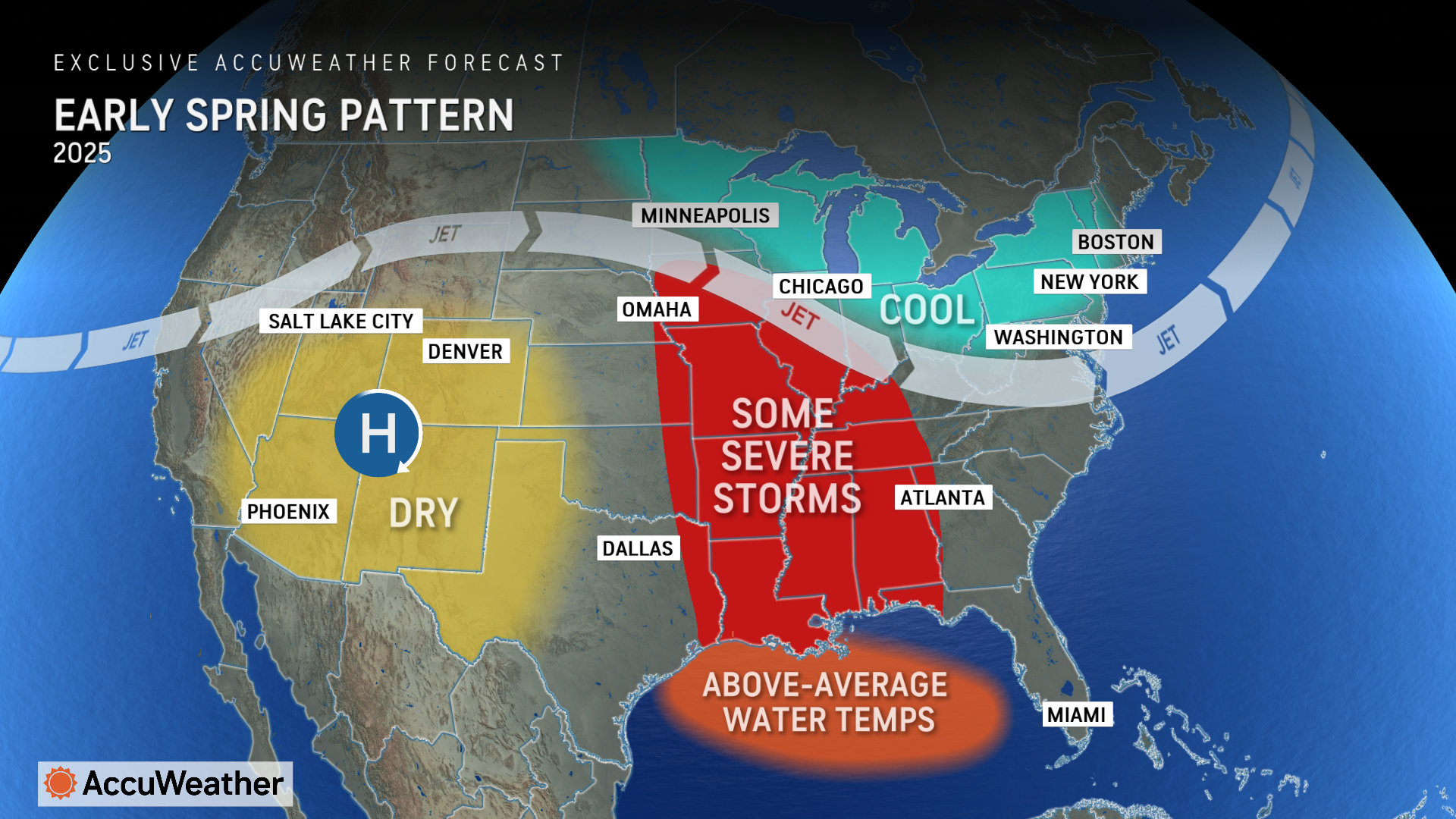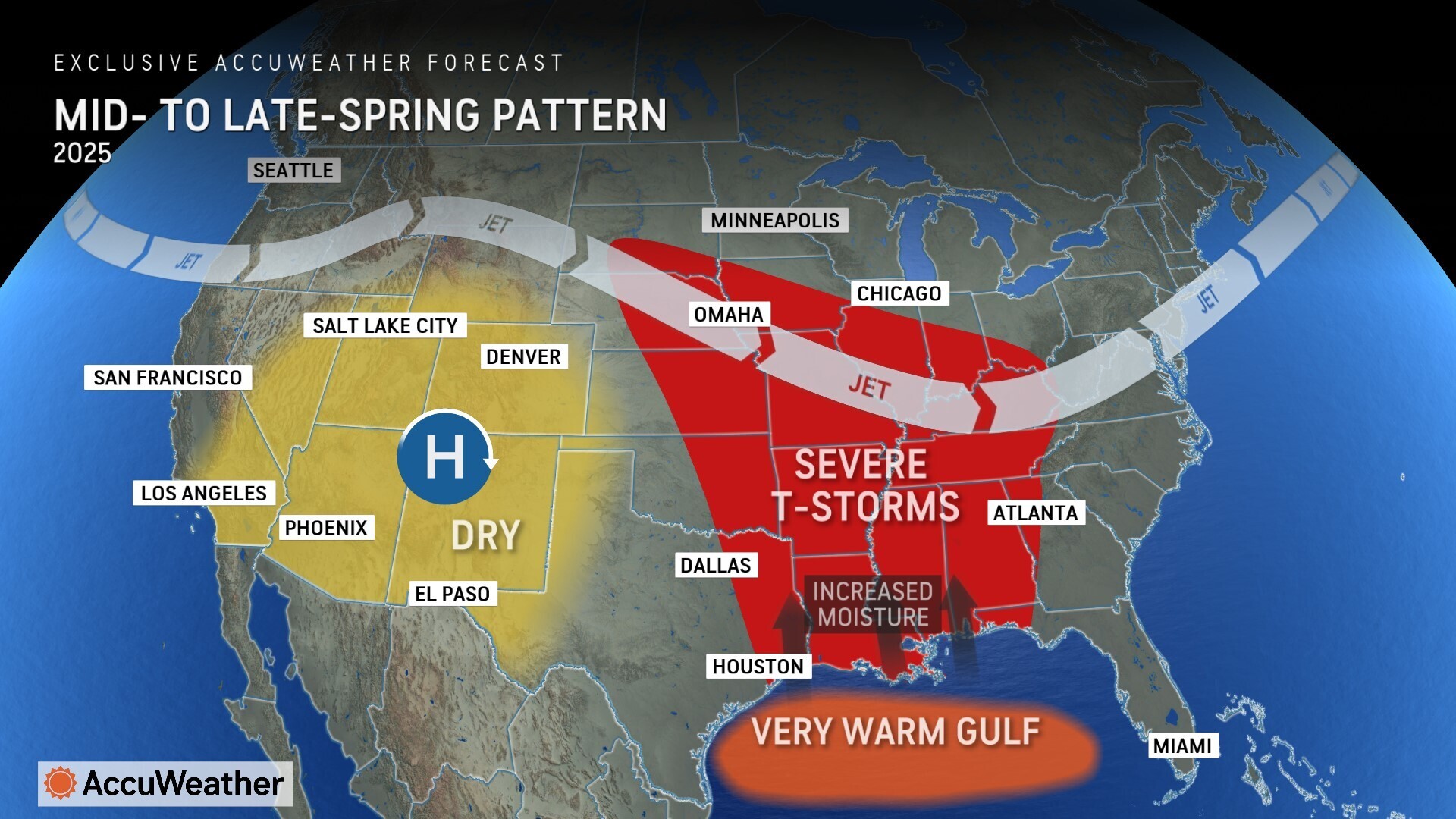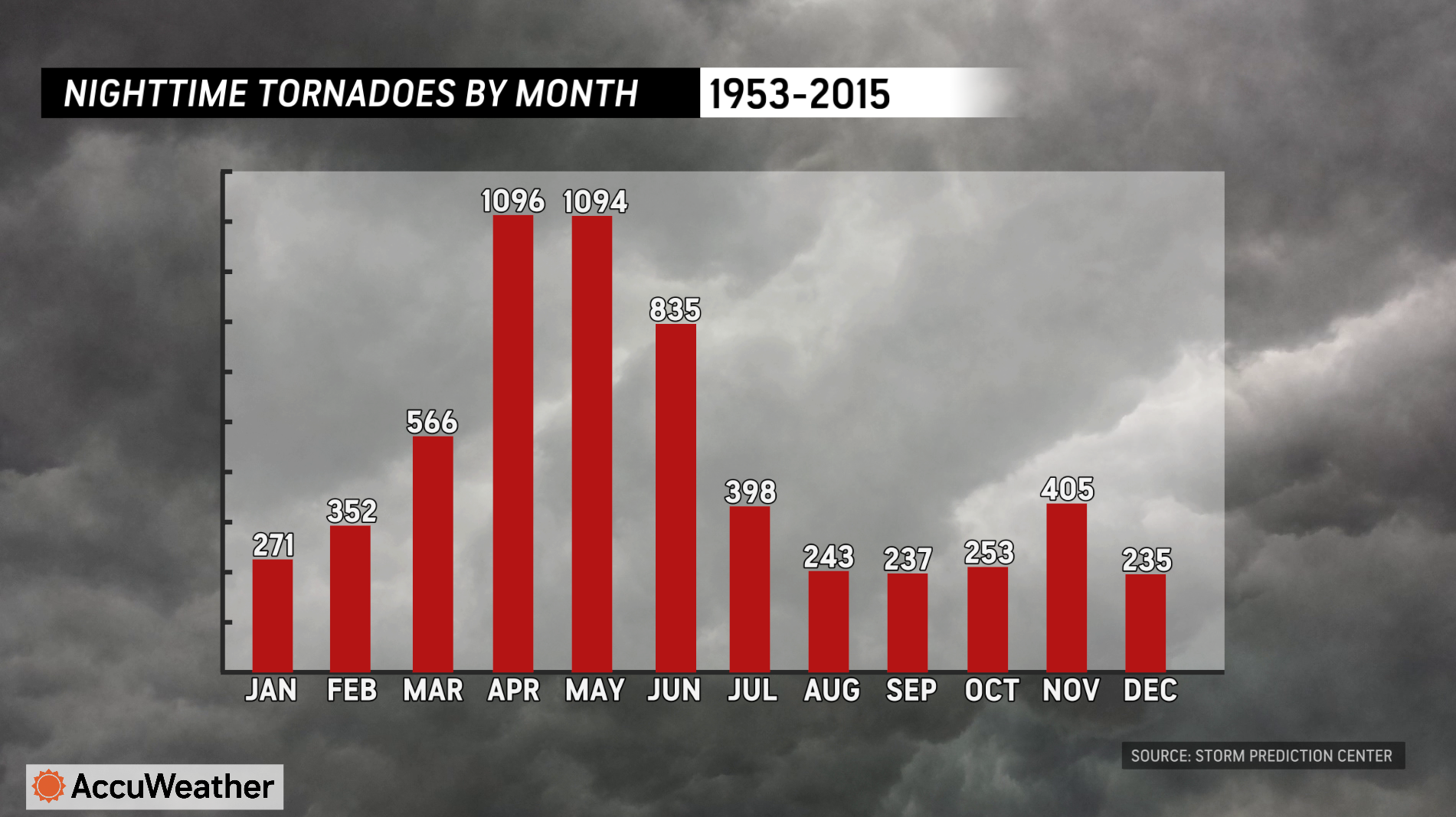AccuWeather meteorologists are available 24/7 to provide further insights and updates on evolving weather conditions. Please contact pr@accuweather.com during regular business hours, or support@accuweather.com or call AccuWeather’s Media Hotline at (814)-235-8710 at any time to arrange interviews with AccuWeather experts or to request the most updated graphics for print or broadcast.
March 5, 2025
Webinar Recording:
AccuWeather Global Weather Center – March. 5, 2025
AccuWeather’s team of long-range experts predicts the greatest concentration of severe thunderstorms and tornadoes will shift back to the Mississippi and Tennessee valleys this year.
The AccuWeather 2025 U.S. Severe Weather Forecast calls for a shift east of the Tornado Alley region in the Plains, which is where many of the tornadoes and other severe weather events happened over the past two years.
“Families and businesses across the Mississippi and Tennessee valleys need to prepare for a stormy spring. Tornado Alley roared back to life in 2023 and 2024, but we expect the highest frequency of severe thunderstorm and tornado threats to shift farther east this year,” AccuWeather Lead Long-Range Expert Paul Pastelok said. “This forecast is concerning because more people are in harm’s way, compared to Tornado Alley. More people live in the Mississippi and Tennessee valleys, and more of those families are in vulnerable buildings without basements like mobile homes.”

AccuWeather 2025 U.S. Severe Weather Forecast
AccuWeather long-range experts predict 1,300-1,450 tornadoes to spin up across the U.S. this year, which is less than the preliminary count of 1,855 tornadoes in 2024.
Pastelok says the season is expected to be slightly above the historical average of 1,225 tornadoes annually, according to records from 1991-2020.
AccuWeather is forecasting 75-150 tornadoes in March, 200-300 tornadoes in April, and 250-350 tornadoes in May.
Last year was the second-worst year for tornadoes on record in the U.S., driven by a surge of tornadoes in May, hurricanes spinning up more than 170 tornadoes, as well as a tornado outbreak in late December.
Texas was the top state for tornado reports in 2024 with 169 tornadoes, followed by Nebraska and Iowa, both reporting 131 tornadoes. Illinois and Missouri rounded out the top five list of states reporting the most tornadoes last year.
More than 100 tornadoes were reported in Florida last year. The unusually high number was caused by Hurricane Milton, which spun up 46 tornadoes, more than twice the daily record number of tornadoes in Florida.
Over 80 tornadoes were reported in Ohio last year after multiple severe weather outbreaks on Feb. 27, March 14, April 2 and May 7.
Oklahoma reported 91 tornadoes, and Illinois reported 126 tornadoes, breaking records for both states last year.
New York reported a noteworthy 32 tornadoes in 2024, compared to just 10 tornadoes the year before.
Tornadoes were reported in every state across the contiguous U.S. in 2024, with the exceptions of Nevada, Vermont and Maine.
Why the risk is shifting east of Tornado Alley this year
As AccuWeather long-range experts accurately predicted, Tornado Alley roared back to life in 2023 and 2024, following years of severe thunderstorms and tornadoes concentrating in the Mississippi and Tennessee valleys.
Pastelok says the focus will return to areas east of Tornado Alley this year due to a large and persistent area of high pressure that is expected to be parked over the Southwest, which could limit severe thunderstorms into part of the Plains.
Exceptionally warm water temperatures in the Gulf will also have a strong influence on severe weather in the Southeast.
Severe thunderstorms to ramp up in April and May
The ingredients for powerful thunderstorms and damaging tornadoes in the central U.S. come together every year starting in March, with the risk of severe weather ramping up through April into May.
Cold air from Canada clashing with warm, moist air from the Gulf provides the fuel and energy for life-threatening thunderstorms to erupt.
Pastelok says this year’s severe weather season is now underway with a few widespread severe weather events expected throughout the month of March in the southern and central U.S.
The cooler start to spring across much of the Great Lakes and Northeast is expected to keep a lid on damaging thunderstorms and tornadoes across Northern states through the early part of the spring.
"Periods of cool and more stable air can cross the Great Lakes, lowering the threat of widespread severe weather this spring across the eastern Ohio Valley, mid-Atlantic, and Northeast," Pastelok said. “There was less ice cover and warmer waters in the Great Lakes at this time last year, which allowed for more opportunities for severe thunderstorms and tornadoes in the Great Lakes and Northeast region.”
The risk of severe thunderstorms is expected to increase in April and become more widespread by May when a shift in the overall weather pattern will open the door for more storms across the Midwest, mid-Atlantic and across parts of the traditional Tornado Alley.
The risk of long-lived, destructive storms, known as derechos, will also be on the rise late in the spring and into the summer. Derechos are also known as "inland hurricanes" due to their intense winds, long tracks, and widespread damage.
"Though it is early to determine where these may form, we are leaning toward the central Plains and mid-Mississippi Valley based on the pattern forecast and research," Pastelok said.
How our warming climate impacts severe thunderstorms and tornadoes
AccuWeather Senior Meteorologist and Climate Expert Brett Anderson says our warming atmosphere can contribute to more impactful and dangerous severe thunderstorms.
“Our warming atmosphere can hold more moisture, unleashing intense rainfall rates that can trigger dangerous flash flooding,” Anderson said. “As water temperatures continue to increase in the Gulf, warmer air with more moisture can be forced northward into the Southern states ahead of a cold front, providing an extra boost of energy for severe thunderstorms that can produce tornadoes.”
Research is ongoing into the influences that a warming climate may have on tornado trends in the U.S.
Climatological records show that the overall number of tornadoes annually has not changed much since the 1970s, but severe weather outbreaks are happening more frequently. Our warming climate is also contributing to an increasing risk of more tornadoes occurring outside of the traditional spring severe weather season.
Records also show that the majority of tornado reports over the past 50 years have shifted out of the traditional Tornado Alley in the Plains and have expanded farther east.
“Researchers are still working to pinpoint possible links and effects that climate change is having on tornadoes in America,” Anderson said. “One thing is clear: extreme weather and billion-dollar disasters are happening more frequently as our climate continues to warm.”
Prepare for extreme weather
AccuWeather expert meteorologists are urging families, businesses, emergency officials, and government leaders across the country to prepare for severe and extreme weather by reviewing safety plans and ensuring storm shelters and safe rooms are ready for use and stocked with supplies.
While the highest likelihood of severe thunderstorms and tornadoes this year is expected to occur in the central and eastern U.S., they can happen anywhere in the country when atmospheric conditions are conducive for severe weather.
Tornadoes have been reported in all 50 states and during every month of the year. AccuWeather experts analyzed decades of records and found that May 25 was the date when the most tornadoes were reported between 1950 and 2020.
Multiple EF5 tornadoes have been reported on May 25 in the past seven decades, most recently in 2008 when an EF5 tornado tore a 43-mile-long path through Iowa, injuring 70 people and killing six others.
Several of the most recent EF5 tornadoes in America also struck in late May including the Joplin, Missouri, EF5 tornado on May 22, 2011, an EF5 tornado near El Reno, Oklahoma, on May 24, 2011, and an EF5 tornado in Moore, Oklahoma, on May 20, 2013.
Tornadoes that strike at night are statistically 2.5 times more deadly than tornadoes that occur during the day. Records show that most nocturnal tornadoes occur during April, May, and June.
AccuWeather expert meteorologists say families and businesses should have multiple ways to receive severe weather warnings and never rely solely on outdoor tornado sirens.
“The AccuWeather app is the best resource to keep your family safe as the spring severe weather season kicks into high gear. Severe weather warnings are delivered faster by the AccuWeather app than any other source, and that’s proven. That advance notice can provide you with more time to get your family to safety,” AccuWeather Chief Meteorologist Jonathan Porter said. “Lightning is another springtime weather threat that can be deadly. AccuWeather Lightning Alerts notify AccuWeather app users when lightning strikes within 10 miles of your location.”
One woman in eastern Tennessee recently told AccuWeather that a tornado warning delivered to her cell phone by the AccuWeather app, faster than any other source, provided her with enough time to get her kids out of their RV and to a neighbor’s home where they were able to take shelter.
AccuWeather Lightning Alerts and severe weather warnings, delivered faster than any other source, are available for free to all AccuWeather app usersin the U.S.





Additional AccuWeather Resources:
Lightning Alerts Now Available on the AccuWeather App
‘Tornado alley’ has been expanding over the past 50 years, new study finds
2024 tornado season was 2nd worst on record, driven by hurricanes
Why nocturnal tornadoes are 2.5 times more deadly
The difference between tornado watches and warnings
How to recognize a 'radar-confirmed tornado'
What to do if you encounter a tornado while driving















